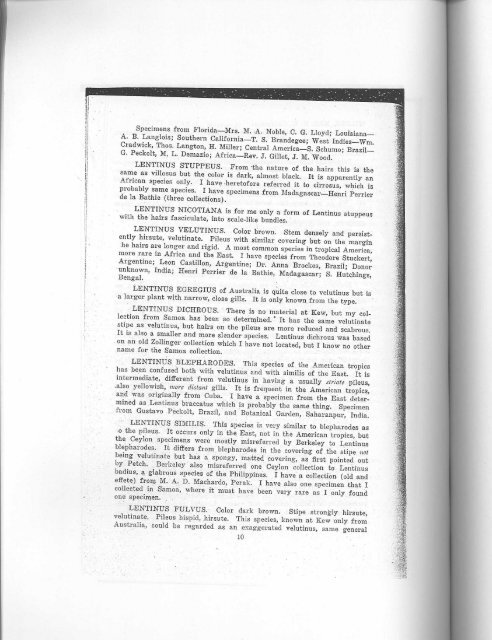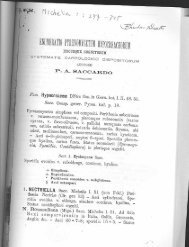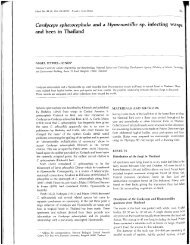t - An Electronic Monograph of Cordyceps and Related Fungi
t - An Electronic Monograph of Cordyceps and Related Fungi
t - An Electronic Monograph of Cordyceps and Related Fungi
You also want an ePaper? Increase the reach of your titles
YUMPU automatically turns print PDFs into web optimized ePapers that Google loves.
Specimens from Florida-Mrs. M. A. Noble, C. G. Lloyd; Louisiana_<br />
A. B. Langlois; Southern California-To S. Bl'<strong>and</strong>egee; West Indies-Wm.<br />
Cradwick, Thos. Langton, H. Miller; Central America-S. Schumo; Brazil-<br />
G. Peckolt, M. L. Demazio; Africa-Rev. J. Gqlet, J. M. Wood.<br />
LENTINUS STUPPEUS. From ·the nature <strong>of</strong> the hairs this is the<br />
same as villosus but the color is dark, almost black. It is a.pparently an<br />
African specie:) only. r have ,heret<strong>of</strong>ore referred it to cinosus, which is<br />
probably s;'une species. r have specimens from Madagascar-Henri Perrier<br />
de la Bathie (three collections).<br />
LENTINUS NICOTIANA is for me only a form <strong>of</strong> Lentinus stuppeus<br />
with the hairs fasciculate, into scale-like bundles.<br />
LENTINUS VELUTINUS. Color brown. Stem densely <strong>and</strong> persistently<br />
hirsute, velutinate. Pileus with similar covering but On the margin<br />
he hairs are longer <strong>and</strong> l'igid. A most common species in tropical America;<br />
more rare in Africa <strong>and</strong> the East. I have species from Theodore Stuckert,<br />
Argentine; Leon Castillon, Argentine; Dr. <strong>An</strong>na Brockes, Brazil; Donor<br />
unknown, India; He:ill'i Perrier de hI. Rathie, Madagascar; S. Hutchings,<br />
Bengal.<br />
LENTINUS EGREGIUS <strong>of</strong> Australia is q~ite close to velutinus but is<br />
a larger plant with narrow, close gills. It is only known from the type. -<br />
LENTINUS DICHROUS. There is no material at Kew, but my collection<br />
from Samoa has been so deter~ine(l. • It has the same velutinate<br />
stipe as velutinus,' but hairs on the pileus are more reduced <strong>and</strong> scabrous.<br />
It is also a smaller <strong>and</strong> more slender species. Lentinus dichrous was based<br />
on an old Zollinger collection which I have not located, but I know no other<br />
name for the Samoa collection.<br />
LENTINUS BLEPHARODES. This species <strong>of</strong> the American tropics<br />
has been confused both with velutiuus <strong>and</strong> with similis <strong>of</strong> th'e East. It is<br />
intermediate, different from velutinus in having a usually striate pileus,<br />
.also yellowish, more d£stant gills. It is frequent in the American tropics,<br />
<strong>and</strong> was ~riginally from Cuba. I have a specimen from the East determined<br />
as Lentinus braccatus which is probably the same thing. Specimen<br />
from Gustavo Peckolt, Brazil, <strong>and</strong> Bo~anical Gurden, Saharanpur, India.<br />
LENTINUS SIMILIS. This species is vel'Y similar to blepharodes as<br />
,0 the pileus. It occurs only in the East, not in the American tropics, but<br />
the Ce~rlon specimens were mostly misl'eferred by Berkeley to ~entinus<br />
blepharodes. It differs from ..blepharodes in the covering <strong>of</strong> the stipe not<br />
being'velutimi.te but has a spongy, matted covel'jng, as first pointed out<br />
by. Petch. Berkeley also misreferred one Ceylon collectio.n to' Lentinus<br />
badius, a glabrous species <strong>of</strong> 'the Philippines. I have a collection (old <strong>and</strong><br />
effete) froIU'M~ A~_D. Machardo, Perak. I have also one specimen -that I<br />
collected in Samoa,<br />
on7 specimen ..<br />
where it must haye been very rare as I only _found<br />
LENTINUS FULVUS. Color dark brown. Stipe strongly hirsute,<br />
velutinate. Pileus hispid, hirsute. This species, known at Kew 'only, from<br />
Australia, could be regarded as an exaggerated velutinus, same general<br />
10








